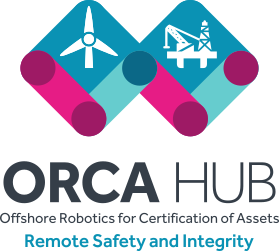The Autonomy and Verification Network is involved in three Robotics and Artificial Intelligence hubs. Each hub focusses on autonomous robotics in a different hazardous environment:
- RAIN Hub for nuclear robotics,
- ORCA Hub for offshore robotics, and
- FAIR-SPACE Hub for space robotics.
You can view our publications on these three hubs, below; and you can keep track of our tweets about the hubs at #HazardousHubs
The research hubs are funded by the UK Research and Innovation Industrial Strategy, which aims to link academia and industry to tackle societal and industrial challenges. The specific aim of the RAI hubs is to “develop robotic solutions to make a safer working environment” for industries like off-shore energy, nuclear energy, and space. Crucially, this requires cross-disciplinary research, which is why each hub has a variety of academic and industrial partners.
Each of these environments might be dull or dirty; and the environments themselves are often dangerous or distant. Dull jobs lead to mistakes; dangerous and dirty jobs are harmful to humans or the environment; and distant jobs make remote control tricky or impossible. Increasing the autonomy of robots in these environments, and the environments themselves, provide challenges for our research; which is generally focussed on verification of the safety of these robotic systems.
Most of our work for the RAI hubs is relevant across all three hubs. Examples of our active strands of work on the RAI hubs include:
- Verifiable, explainable autonomous systems;
- Verification of robot plans and reconfigurations;
- Verifiable runtime monitoring of safety properties;
- Linking the verification of heterogeneously specified components;
- Planning around unseen hazards, such as wind;
- Ensuring verification evidence is suitable for certification.
Robotics and AI In Nuclear
The Robotics and AI In Nuclear (RAIN) Hub aims to tackle the challenges of increasing the level of autonomy of robotic systems within the UK’s civilian nuclear industry.
Major challenges:
- Radiation restricts human intervention, hardware choices, and sensors;
- Radiation also presents an invisible hazard; and,
- The nuclear industry has needfully strict certification requirements.
More information can be found on the RAIN Hub website and at @RAIN_hub.
Offshore Robotics for Certification of Assets
The Offshore Robotics for Certification of Assets (ORCA) Hub aims to enable autonomous robotic systems for inspecting offshore assets, such as wind turbines and oil rigs.
Major Challenges:
- The robotic system's environment, such as the wind and sea state, can change rapidly;
- Wind and sea can also pose invisible, or hard to detect, hazards;
- Hazardous environment also restricts human intervention.
More information can be found on the ORCA Hub website and at @ORCA_Hub.
Future AI and Robotics for Space
The Future AI and Robotics for Space (FAIR Space) Hub aims to develop autonomous robotic systems for use in space exploration.
Major Challenges:
- Robots are so remote that human intervention is impossible;
- Distance also causes a communications delay;
- Robotic systems designed for remote access are vulnerable to security threats.
More information can be found on the FAIR-SPACE Hub website and at @FAIR_SPACE_Hub.
RAI Hubs Publications



